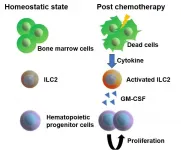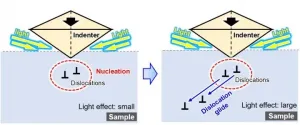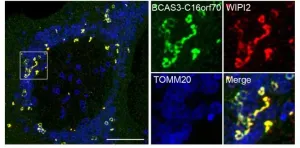Monoclonal antibody "cocktail" blocks COVID-19 variants: Study
2021-03-05
(Press-News.org) A monoclonal antibody "cocktail" developed at Vanderbilt University Medical Center (VUMC) to neutralize the COVID-19 virus is effective against all known strains, or variants, of the virus, according to a report published in the journal Nature Medicine.
That was one of the findings reported by a multi-institutional team led by researchers at Washington University School of Medicine in St. Louis.
In cell-culture studies, the researchers determined the ability of monoclonal antibodies as well as antibodies isolated from the "convalescent plasma" of previously infected people to neutralize highly transmissible variants of the SARS-CoV-2 virus that have arisen in the United Kingdom, South Africa, Brazil and elsewhere.
In general, most of the monoclonal antibodies that have been developed to combat COVID-19 showed "diminished neutralizing potency," specifically against strains of the virus bearing a specific mutation at position 484 in the surface "spike" protein, which enables the virus to attach to and enter its host cell in the body.
However, several other highly neutralizing monoclonal antibody cocktails, including those developed at VUMC, showed intact or only mildly diminished activity against the variants tested, possibly because they target sites on the spike protein other than the highly mutable E484K residue.
The study indicated substantially reduced neutralization of variants viruses containing this E484K mutation by antibodies in the sera of both previously infected and COVID-19 vaccinated individuals, further highlighting the need for variant-resistant treatments like the VUMC antibody cocktail.
"This study highlights the importance of rationally designed antibody cocktails like those we developed," said James Crowe, Jr., MD, director of the Vanderbilt Vaccine Center (VVC) and Ann Scott Carell Professor in the Departments of Pediatrics and Pathology, Microbiology and Immunology at Vanderbilt.
"We chose two antibodies to create a mixture that specifically would resist escape by SARS-CoV-2," Crowe said. "Fortunately, this work and several other papers recently published show that the protection mediated by the antibodies we discovered that are now in six different phase 3 clinical trials should extend to all current variants of concern."
Robert Carnahan, PhD, associate VVC director and associate professor of Pediatrics, added, "These findings that the antibodies we are developing inhibit the new SARS-CoV-2 variants well are made even more important by the fact that some previously approved monoclonal antibody treatments look very unlikely to protect against these variants.
"Using our variant-resistant antibody cocktails likely will provide an important new tool for controlling the COVID-19 pandemic," Carnahan said.
INFORMATION:
During the past two-and-a-half years, VUMC researchers have developed ultra-fast methods?for discovering highly potent antiviral human monoclonal antibodies and validating their ability to protect small animals and non-human primates.
The VUMC antibodies described in the paper published today - COV2-2196 and COV2-2130 -- were isolated from the blood of a couple from Wuhan, China, who were diagnosed with COVID-19 after traveling to Toronto in January 2020. They were two of the earliest confirmed cases of COVID-19 in North America.
The antibodies were among six that were licensed to the global biopharmaceutical company AstraZeneca in June for advancement into clinical development. In October the company announced it was advancing into phase 3 clinical trials an investigational therapy consisting of two long-acting antibodies discovered at VUMC and optimized by AstraZeneca.
Today's study also included researchers from the University of Texas Medical Branch in Galveston, the University of Texas Southwestern Medical Center in Dallas, and the Swiss firm Vir Biotechnology.
Others from VUMC who contributed to the research were Naveen Suryadevara, PhD, Pavlo Gilchuk, PhD, and Seth Zost, PhD.
The research at VUMC was supported by the National Institute of Allergy and Infectious Diseases, part of the National Institutes of Health, the Defense Advanced Research Projects Agency of the U.S. Department of Defense, the Dolly Parton COVID-19 Research Fund at Vanderbilt, and Merck KGaA, Darmstadt, Germany.
[Attachments] See images for this press release:

ELSE PRESS RELEASES FROM THIS DATE:
2021-03-05
Can Switzerland, as planned, cut its CO2 emissions to zero by 2050? In a study, researchers at the Paul Scherrer Institute PSI have investigated what measures would be necessary to achieve this reduction and how much it might cost per person.
In August 2019, the Swiss Federal Council decided on an ambitious target to limit climate change: From the year 2050 onward Switzerland should, on balance, discharge no further greenhouse gas emissions. With this commitment, Switzerland meets the internationally agreed goal of limiting global warming to a maximum of 1.5° C compared to the pre-industrial era.
Now a study by the Paul Scherrer Institute, ...
2021-03-05
Functioning ecosystems provide the basis for security, basic material needs, health, social interaction and individual liberty. This is how the Millennium Ecosystem Assessment 2005 described it, dividing ecosystem services into the following categories: The provisioning services; goods such as food, water, firewood and timber, the regulating services; pollination, water filtering function of the soil, flood and erosion protection, and the cultural services; recreation, places of inspiration, and education. Many of these services are indirectly and directly linked to the presence of species. For this reason, species conservation is often put forward as a measure for the conservation of vital natural services.
"However, most previous ...
2021-03-05
PHILADELPHIA - Intellectual disability puts individuals at higher risk of dying earlier in life than the general population, for a variety of medical and institutional reasons. A new study from Jefferson Health examined how the COVID-19 pandemic has affected this group, which makes up 1-3% of the US population. The study, published today in the New England Journal of Medicine (NEJM) Catalyst, found that intellectual disability was second only to older age as a risk factor for dying from COVID-19.
"The chances of dying from COVID-19 are higher for those with intellectual disability than they are for people with congestive heart failure, kidney disease or lung disease," says lead author Jonathan Gleason, MD, the James D. and Mary Jo Danella ...
2021-03-05
Osaka, Japan - Chemotherapy has a damaging effect on hematopoietic stem and progenitor cells (HSPCs) in bone marrow. However, once chemotherapy ends, HSPCs regenerate, a process that has remained unknown--until now. In a new study, researchers from Osaka University have identified the molecular mechanism by which HSPCs recover after injury.
HSPCs reside in the bone marrow and give rise to several types of blood cells, such as red blood cells (which carry oxygen), some white blood cells (which are important for the immune system) and platelets (which are necessary to stop bleeding). Because HSPCs constantly divide to generate new cells, they are particularly sensitive to injury induced by, for example, chemotherapy. ...
2021-03-05
Semiconductor materials play an indispensable role in our modern information-oriented society. For reliable performance of semiconductor devices, these materials need to have superior mechanical properties: they must be strong as well as resistant to fracture, despite being rich in nanoscale structures.
Recently, it has become increasingly clear that the optical environment affects the structural strength of semiconductor materials. The effect can be much more significant than expected, especially in light-sensitive semiconductors, and particularly since due to technological constraints ...
2021-03-05
Background: Although caregivers of patients with eating disorders usually experience a heavy caregiving burden, the effects of social support on caregivers of patients with eating disorders are unknown. This study aimed to investigate how social support for mothers who are caregivers of patients with an eating disorder improves the mothers' mental status and, consequently, the symptoms and status of the patients.
Methods: Fifty-seven pairs of participants were recruited from four family self-help groups and one university hospital in Japan. Recruitment was conducted from July 2017 to August 2018. Mothers were ...
2021-03-05
Autophagy is an intracellular degradation process of cytosolic materials and damaged organelles. Researchers at Ubiquitin Project of TMIMS have been studying the molecular mechanism of mitophagy, the selective autophagy process to eliminate damaged mitochondria. PINK1 (a serine/threonine kinase) and Parkin (a ubiquitin ligating enzyme: E3) work together to ubiquitylate the outer membrane proteins of damaged mitochondria, then ubiquitin chains are recognized as signals for autophagy degradation. Dysfunction of mitophagy causes a decrease in mitochondrial quality with overproduction of ROS, and is linked to neurodegenerative diseases like Parkinson's disease.
In Autophagy machinery, cellular components targeted for degradation are engulfed by phosphatidylinositol-3-phosphate (PI3P)-rich ...
2021-03-05
Frequently occurring chronic skin inflammation like in atopic dermatitis (AD or neurodermatitis) and psoriasis have different causes such as genetic predisposition, stress or allergens. These frequently occurring skin diseases are mostly attributed by biomedical scientists to a disturbed immune system, although the noticeable thickening and flaking of the epidermis, which is the outermost layer of skin, also indicates a disruption of the epithelial cells. A team of researchers from the University Clinic for Dermatology and the Clinical Institute for Laboratory Medicine at MedUni Vienna has now been able to identify new molecular ...
2021-03-05
WHO: Giovanni Traverso, MB, BChir, PhD, Associate Physician, Division of Gastroenterology, Brigham and Women's Hospital; corresponding author of a new article published in JAMA Network Open.
Peter Chai, MD, MMS, Assistant Professor, Department of Emergency Medicine, Brigham and Women's Hospital; first author.
WHAT: In the age of COVID-19, mobile robotic telehealth systems could help clinicians and patients interact without contact. Last spring, some health care systems deployed robotic systems within a hospital to evaluate and interact with patients. In a JAMA Network Open article, Traverso and colleagues report the results of a national survey and a cohort study in an emergency department (ED), which analyzed patients' satisfaction with an initial evaluation ...
2021-03-05
MoS2 thin films of superposed alternating layers of molybdenum and sulfur atoms form a two-dimensional semiconducting surface. However, even a surprisingly low-intensity blue light pulse is enough to alter the properties of the surface and make it metallic. This has now been demonstrated by a team at BESSY II.
The exciting thing is that the MoS2 layers in this metallic phase are also particularly active catalytically. They can then be employed, for example, as catalysts for splitting of water into hydrogen and oxygen. As inexpensive catalysts, they could facilitate the production of hydrogen - an energy ...
LAST 30 PRESS RELEASES:
[Press-News.org] Monoclonal antibody "cocktail" blocks COVID-19 variants: Study






